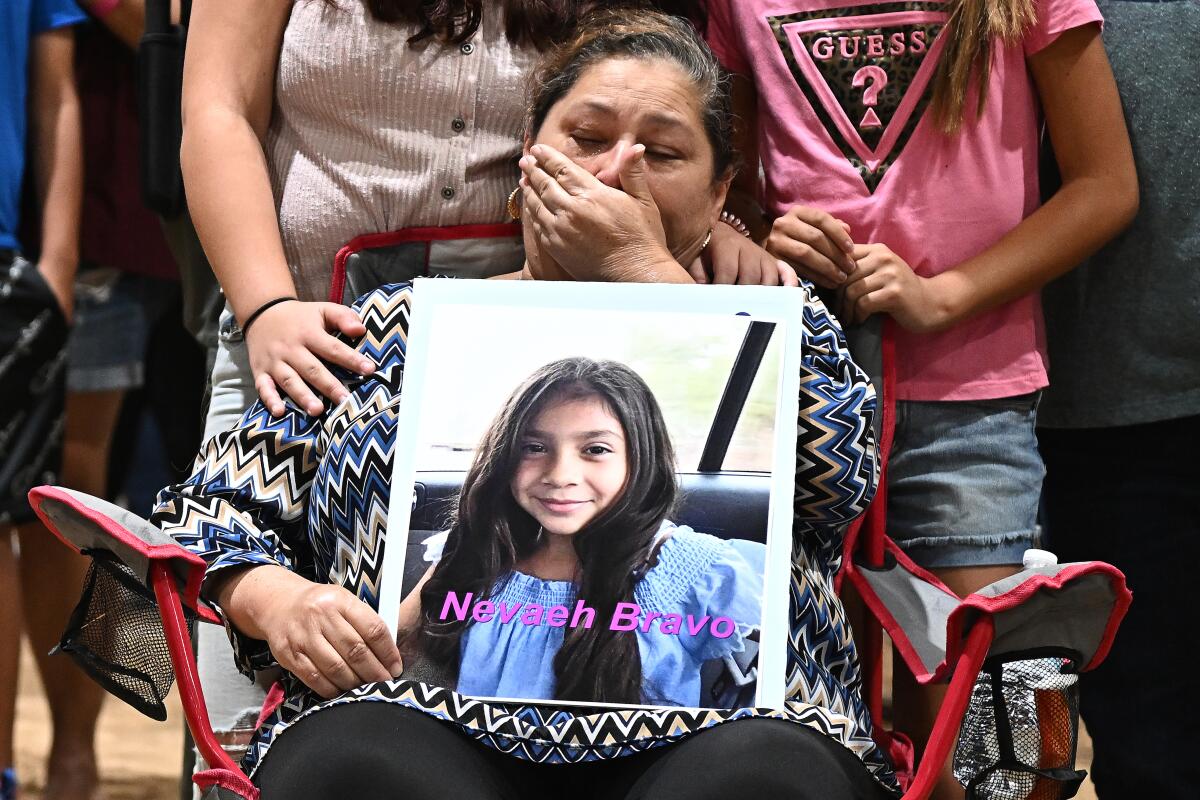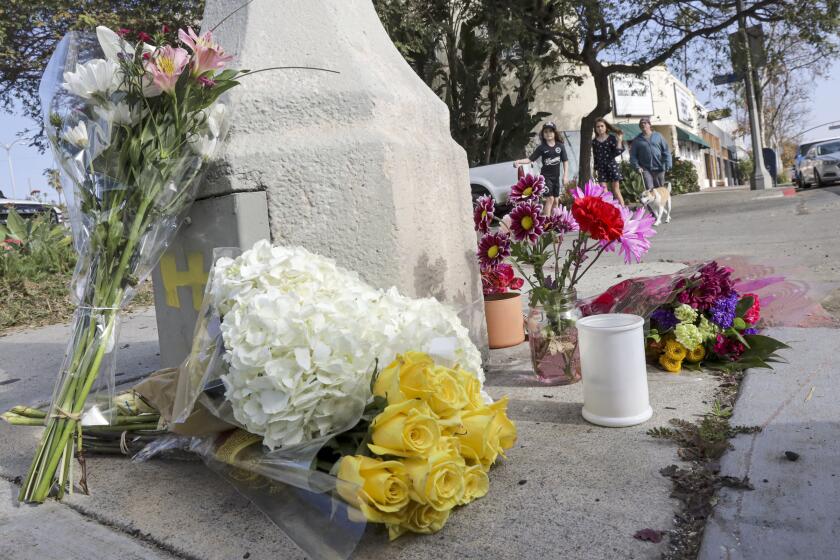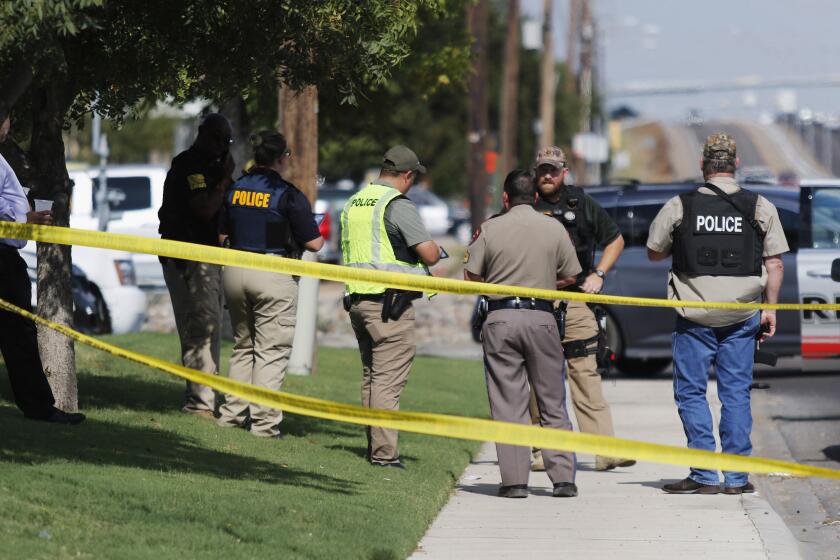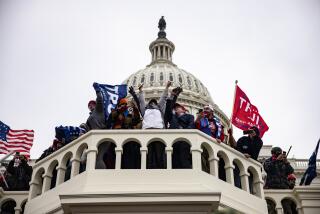Column: We don’t have to live like this. Our children don’t have to die like this

- Share via
I’ve always wondered how vigorously gun-loving Americans would defend assault rifles if they were forced to see up close the damage the weapons inflict on human bodies.
In the aftermath of school shootings, we’ve become accustomed to certain images: distraught parents clutching terrified children, police officers swarming, photo collages of smiling young faces frozen forever as first-graders or fourth-graders or teenagers.
But what if we had to actually confront the carnage? It would be unbearable.
Did you know, for example, that rounds fired from assault rifles travel at such a high speed they cause a shock wave while passing through a human body? These waves, experts say, result in catastrophic injuries “even in areas remote to the direct bullet wound.”
Imagine what Nicole Hockley’s first-grader Dylan must have looked like after five bullets tore through his little body at Sandy Hook Elementary School before Christmas in 2012.
And what about the 19 fourth-graders in Uvalde, Texas? Did you wonder why their relatives had to provide DNA samples? The Wall Street Journal reported that their bodies lay in multiple piles in their classroom. Imagine a bloody pile of dead children, with two lifeless teachers slumped over them.
Maybe the national ardor for assault weapons would start to cool if we could actually see the havoc they are wreaking.
Maybe the politicians who pretend they are powerless to prevent the bloodshed would be shamed into action if they had to face the graphic result of their refusal to act.
Maybe Texas Gov. Greg Abbott would not have tweeted three years after 20 schoolchildren in Newtown, Conn., were slaughtered that he was “embarrassed” to see Texas behind California in new gun sales. “Let’s pick up the pace Texans,” he wrote.
We don’t have to live like this. Our children don’t have to die like this. There is so much we can do.
Most accidents are predictable and preventable, but companies and government are invested in blaming the victims.
We must ban assault weapons, or at the very least raise the minimum age to purchase them. We must pass and enforce “red flag laws” to prevent emotionally unstable people from keeping their guns. We must widen background checks.
We must push senators to end the filibuster, which has made any sort of gun law reform unlikely. The moral bankruptcy of politicians on this issue is perfectly symbolized by Sen. Joe Manchin III (D-W.Va.), who said he would do “anything I can” to pass new gun legislation, except the one thing he really can do — vote to end the filibuster.
Lately, I’ve tried to tune out the gun debate because it’s just so sickening to live in a country that fetishizes instruments of death. But this week, in the aftermath of Uvalde, I forced myself to read up on guns because I can no longer look away.
Did you know that workplace shootings are considered rare? According to a National Review article, this “may well indicate that the background-check system is working” because the vast majority of workplace employees are adults, “and if an adult accumulates a criminal record or has a restraining order filed against him, he is barred from purchasing a firearm.”
The 18-year-old arrested in the Buffalo mass shooting and the 18-year-old responsible for the deaths in Uvalde weren’t old enough to accrue criminal records. But they were able to buy assault rifles the day they turned 18. A federal assault weapons ban would have prevented the deaths of 31 people.
Did you know that a 2019 study found that between 1981 and 2017, mass shooting deaths were 70% less likely to occur while the country’s decade-long assault ban was in effect? How many children would still be alive today if the Senate had not refused to ban the sale of assault weapons in 2013?
Did you know that nearly half of mass shooters leak their plans in advance?
Wallow in grief. Be horrified. Be angry. Be committed to the idea that we’re all in the line of fire, that it could have been any of us, anywhere, at any time, because no one and nowhere is safe.
Did you know that one-third of American adults say that fear of mass shootings has led them to avoid certain places and events?
::
When news broke about the Uvalde shooting, filmmaker Kim Snyder was on her way to Kenya to screen “Us Kids,” her documentary about the March for Our Lives movement founded by the student survivors of the 2018 massacre at Marjory Stoneman Douglas High School in Parkland, Fla. She also made “Newtown,” an award-winning 2016 documentary about the aftermath of the mass shooting that took the lives of 20 first-graders and six adults.
When I reached her by phone, she told me she’d been crying a lot.
“I’m sitting here in Africa at a dinner party where these Kenyans are politely just so not understanding it,” she said. “I have never been more ashamed. This is a human rights issue for the children of America.”
When I asked her what she thought about publishing photos of children killed in mass shootings, she reminded me that some of the Sandy Hook parents went to court to stop images of their children from being disseminated online. She supported them. “I know there is this idea of the ‘greater good,’ ” she said, “but we have to protect first and foremost the parents.”
In 1955, after 14-year-old Emmett Till was tortured and lynched by white men in Mississippi, his mother insisted on an open casket at his public funeral in Chicago. Mamie Till-Mobley wanted the world to see the horror that had been inflicted on her child. She invited news photographers to take pictures. Fifty-thousand people saw Emmett’s mutilated body in person. Some went weak, some fainted, some threw up. But the mother’s brave act, awful as it was, helped galvanize the civil rights movement and change the course of history.
More to Read
A cure for the common opinion
Get thought-provoking perspectives with our weekly newsletter.
You may occasionally receive promotional content from the Los Angeles Times.














